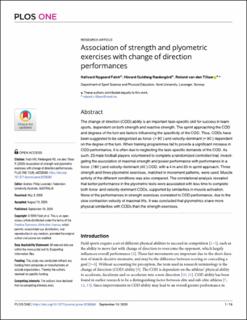Association of strength and plyometric exercises with change of direction performances
Peer reviewed, Journal article
Published version

View/
Date
2020Metadata
Show full item recordCollections
Original version
Falch, H. N., Rædergård, H. G. & van den Tillaar, R. (2020). Association of strength and plyometric exercises with change of direction performances. PLOS ONE, 15(9): e0238580. doi: 10.1371/journal.pone.0238580Abstract
The change of direction (COD) ability is an important task-specific skill for success in team sports, dependent on both strength and reactive strength. The sprint approaching the COD and degrees of the turn are factors influencing the specificity of the COD. Thus, CODs have been suggested to be categorized as force- (> 90°) and velocity-dominant (< 90°) dependent on the degree of the turn. When training programmes fail to provide a significant increase in COD performance, it is often due to neglecting the task-specific demands of the COD. As such, 23 male football players volunteered to complete a randomized controlled trial, investigating the association of maximal strength and power performance with performance in a force- (180°) and velocity-dominant (45°) COD, with a 4 m and 20 m sprint approach. Three strength and three plyometric exercises, matched in movement patterns, were used. Muscle activity of the different conditions was also compared. The correlational analysis revealed that better performance in the plyometric tests were associated with less time to complete both force- and velocity-dominant CODs, supported by similarities in muscle activation. None of the performances in strength exercises correlated to COD performance, due to the slow contraction velocity of maximal lifts. It was concluded that plyometrics share more physical similarities with CODs than the strength exercises.
